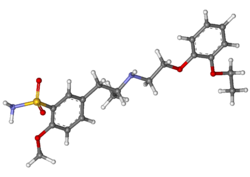Tamsulosin
 |
|
 |
|
| Clinical data | |
|---|---|
| Pronunciation | /tæmˈsuːləsən/ |
| Trade names | Flomax, Omnic |
| AHFS/Drugs.com | Monograph |
| MedlinePlus | a698012 |
| License data |
|
| Pregnancy category |
|
| Routes of administration |
by mouth |
| ATC code | G04CA02 (WHO) |
| Legal status | |
| Legal status | |
| Pharmacokinetic data | |
| Bioavailability | 100% (by mouth) |
| Metabolism | hepatic |
| Biological half-life | 9–13 hours |
| Excretion | 76% kidney |
| Identifiers | |
|
|
| CAS Number |
106133-20-4 |
| PubChem (CID) | 129211 |
| IUPHAR/BPS | 488 |
| DrugBank |
DB00706 |
| ChemSpider |
114457 |
| UNII |
G3P28OML5I |
| KEGG |
D08560 |
| ChEBI |
CHEBI:9398 |
| ChEMBL |
CHEMBL836 |
| ECHA InfoCard | 100.109.780 |
| Chemical and physical data | |
| Formula | C20H28N2O5S |
| Molar mass | 408.51 |
| 3D model (Jmol) | Interactive image |
|
|
|
|
Tamsulosin, sold under the trade name Flomax, is a medication used to treat symptomatic benign prostatic hyperplasia (BPH), help with the passage of kidney stones, and for urinary retention along with other measures.
Tamsulosin, and other medications in the class called alpha blockers, work by relaxing bladder neck muscles and muscle fibers in the prostate itself and make it easier to urinate. It is an α1a adrenergic receptor antagonist.
Tamsulosin was developed by Yamanouchi Pharmaceuticals (now part of Astellas Pharma) and was first marketed in 1996. The U.S. patent expired in October 2009. The U.S. Food and Drug Administration (FDA) approved generics in March 2010.
Tamsulosin is primarily used for benign prostatic hyperplasia and to help with the passage of kidney stones. Tamsulosin, however, appears to be effective only for stones over 4 mm and less than 10 mm in size.
Tamsulosin is also used as an add on treatment for acute urinary retention. People may void more successfully after catheter removal if they are taking tamsulosin. People taking tamsulosin are also less likely to need re-catheterization.
Tamsulosin has also affected sexual function in men. It can cause males to experience retrograde ejaculation. In males, retrograde ejaculation occurs when the fluid to be ejaculated, which would normally exit the body via the urethra, is redirected to the urinary bladder. Normally, the bladder sphincter contracts and the ejaculate goes to the urethra, the area of least pressure. In retrograde ejaculation, this sphincter does not function properly. This side effect can be mitigated by exercising the sphincter muscle; this is done by practicing a pumping action during ejaculation and urination - some semen fluid can then be ejaculated.
...
Wikipedia
